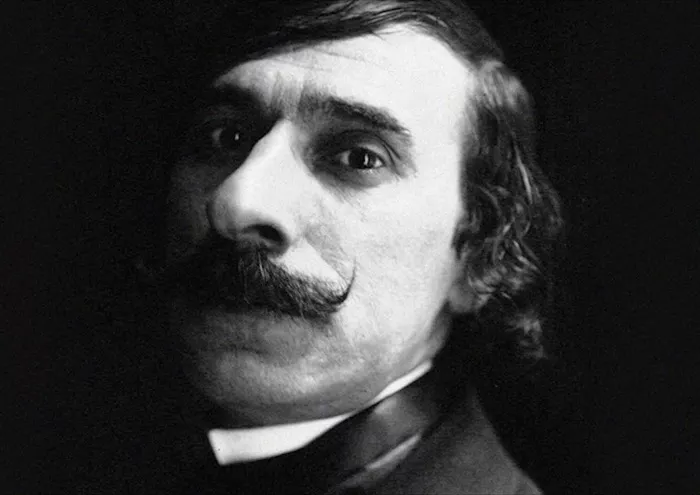Paul Fort (1872–1960) stands as a significant figure in the landscape of 19th century French poetry. Known for his association with the Symbolist movement, Fort’s contributions to French poetry are both extensive and influential. His work, characterized by innovation and a deep connection to French literary traditions, offers a unique perspective on the evolution of poetry during a transformative period in France’s cultural history.
Paul Fort
Born on February 1, 1872, in Reims, France, Paul Fort moved to Paris with his family in 1878. He pursued his education at the Lycée Louis-le-Grand, where he became acquainted with notable literary figures such as Pierre Louÿs and André Gide. These early connections played a pivotal role in shaping his literary inclinations and introducing him to the vibrant artistic circles of Paris.
Theatrical Endeavors and the Symbolist Movement
At the age of 18, Fort reacted against the prevailing Naturalistic theatre by founding the Théâtre d’Art (1890–93). This initiative aimed to provide a platform for Symbolist plays, emphasizing mood and atmosphere over realistic representation. The Théâtre d’Art introduced French audiences to works by playwrights such as Maurice Maeterlinck, Henrik Ibsen, and August Strindberg, thereby influencing the trajectory of French theatre.
Fort’s involvement in the Symbolist movement extended beyond theatre. He co-founded and edited literary reviews like Le Livre d’Art and Vers et Prose, collaborating with poets such as Guillaume Apollinaire and Paul Valéry. These publications became instrumental in disseminating Symbolist literature and fostering a community of like-minded writers.
Literary Contributions: Ballades Françaises
Fort’s most renowned literary achievement is his extensive series titled Ballades Françaises. Between 1897 and 1924, he produced over thirty volumes under this title, showcasing his dedication to the ballad form and his commitment to exploring French themes and landscapes.
His ballads are noted for their rhythmic prose and lyrical quality, blending traditional forms with innovative stylistic choices. Amy Lowell, an American poet and critic, recognized Fort’s creation of the polyphonic prose form in his Ballades Françaises, highlighting his influence on modern poetic structures.
Recognition and Influence
In 1912, Fort’s contributions to French poetry were formally acknowledged when he was bestowed the title “Prince of the Poets,” a distinction previously held by luminaries such as Paul Verlaine and Stéphane Mallarmé. This honor reflected his standing within the French literary community and his impact on contemporary poetry.
Fort’s influence extended beyond literature into the realm of music. His poem “Le Petit Cheval” (“The Little Horse”) was popularized in France by the folk singer Georges Brassens, who set it to music in 1952, demonstrating the adaptability and enduring appeal of Fort’s poetic works.
Comparative Analysis with Contemporaries
To fully appreciate Fort’s place in 19th century French poetry, it is instructive to compare his work with that of his contemporaries.
Stéphane Mallarmé (1842–1898)
Mallarmé, a central figure in the Symbolist movement, is known for his complex and hermetic poetry. While both Mallarmé and Fort were associated with Symbolism, Fort’s poetry is generally more accessible, favoring clarity and musicality over abstraction. This distinction highlights Fort’s unique approach within the movement, balancing symbolic depth with readability.
Paul Verlaine (1844–1896)
Verlaine’s poetry is characterized by its musicality and emotional nuance. Fort shared Verlaine’s emphasis on rhythm and sound but diverged in thematic focus. Where Verlaine often delved into personal and romantic themes, Fort’s Ballades Françaises frequently explored national identity and collective experience, reflecting a broader societal perspective.
Paul Valéry (1871–1945)
Valéry, a fellow editor of Vers et Prose, was known for his philosophical and introspective poetry. While both poets valued form and intellectual rigor, Fort’s work is distinguished by its engagement with everyday life and its celebration of French culture. This contrast underscores the diversity within French poetry during this period and Fort’s commitment to making poetry resonate with a wider audience.
Conclusion
Paul Fort’s contributions to 19th century French poetry are marked by innovation, accessibility, and a deep connection to national identity. His efforts to revitalize traditional forms and his role in promoting Symbolist literature have left an indelible mark on French literary history.
As a French poet who bridged the gap between tradition and modernity, Fort’s work continues to be studied and appreciated for its stylistic elegance and cultural significance. His legacy endures as a testament to the richness and diversity of French poetry at the turn of the century.

